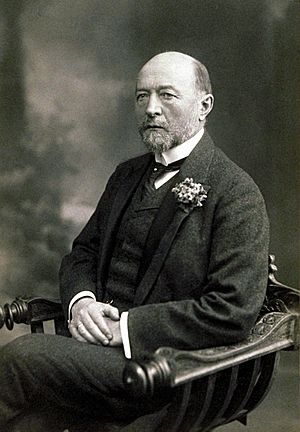Emil von Behring facts for kids
Quick facts for kids
Emil von Behring
|
|
|---|---|

Emil Adolf von Behring
|
|
| Born |
Adolf Emil Behring
15 March 1854 Hansdorf, Kreis Rosenberg in Westpreußen, Province of Prussia, Kingdom of Prussia, German Confederation
(now Poland) |
| Died | 31 March 1917 (aged 63) |
| Nationality | German |
| Known for | Diphtheria antitoxin/serum |
| Awards | Cameron Prize for Therapeutics of the University of Edinburgh (1894) Nobel Prize in Physiology or Medicine (1901) |
| Scientific career | |
| Fields | Physiology, immunology, ophthalmology |
| Notable students | Hans Schlossberger |
Emil von Behring (born Emil Adolf Behring) was a famous German physiologist. He was born on March 15, 1854, and passed away on March 31, 1917. He won the very first Nobel Prize in Physiology or Medicine in 1901. He earned this award for finding a special medicine called a diphtheria antitoxin.
Many people called him a "saviour of children." This is because diphtheria used to cause many children to die. His important work on diphtheria and tetanus made him very famous. In 1901, he received a special honor from Prussia. After that, he was known as "von Behring."
Contents
Early Life and Education
Emil von Behring was born in a place called Hansdorf. This area is now part of Poland. His father was a school teacher. Emil grew up in a large family with 13 children.
Studying Medicine
From 1874 to 1878, Emil studied medicine. He went to the Kaiser-Wilhelm-Akademie in Berlin. This was a special school for military doctors. His family could not afford a regular university.
Because he studied at a military academy, he had to serve in the army. For every semester he studied, he owed one year of service. He worked as a military surgeon from 1881 to 1883. During this time, he also studied eye diseases. He wrote about eye surgery and treatments.
In 1878, he was sent to Poland. There, he focused on diseases caused by infections. People began to notice his great potential. This led to him being called back to Prussia. He then got to study with the famous scientist Robert Koch.
Discovering Antitoxins
In 1890, Emil von Behring published an important paper. He worked with another scientist, Kitasato Shibasaburō. They announced that they had found "antitoxins" for diphtheria and tetanus.
They injected small amounts of diphtheria and tetanus poisons into animals. These animals included guinea pigs, goats, and horses. When the animals became immune, they took a part of their blood called serum. This serum contained the antitoxins, which we now know are antibodies.
Behring called this process "serum therapy." He said it could give lasting protection against diseases. These antitoxins could protect animals that were not immune. They could also help cure sick animals.
In 1892, Behring tried using the diphtheria antitoxin on humans. These first attempts were not successful. But by 1894, he had made the antitoxin better. He also found ways to measure how much antitoxin was needed. After this, the treatment started to work well. In 1894, he also received the Cameron Prize from the University of Edinburgh.
Nobel Prize and Later Work
In 1895, Emil von Behring became a professor. He taught about hygiene at the University of Marburg. He kept this job for the rest of his life. His laboratory was in the same building as another scientist, Hans Horst Meyer. Behring encouraged Meyer to study how the tetanus poison works.
Behring won the first Nobel Prize in Physiology or Medicine in 1901. This was for his work on serum therapies against diphtheria. In 1902, he became an honorary member of the American Academy of Arts and Sciences.
In 1904, he started his own company in Marburg. It was called Behringwerke. This company made antitoxins and vaccines.
In 1905, he announced a new discovery. He found a substance from the tuberculosis virus. He called it "T C." This substance was important in his "bovivaccine." This vaccine helped prevent tuberculosis in cows. He tried to find a way to protect and treat humans, but he was not successful.
Emil von Behring died in Marburg on March 31, 1917. His name lives on in several companies today. These include CSL Behring and Siemens Healthineers (which used to be Dade Behring). The University of Marburg also has a special award named after him. It is called the Emil von Behring Prize.
His Nobel Prize medal is now on display. You can see it at the International Red Cross and Red Crescent Museum in Geneva.
Personal Life
On December 29, 1896, Emil von Behring married Else Spinola. She was 20 years old at the time. Else's father was the director of the Charité hospital in Berlin. Emil and Else had six sons.
They spent their honeymoon in 1897 at a villa called "Behring" on Capri. Emil owned this vacation home.
See also
 In Spanish: Emil Adolf von Behring para niños
In Spanish: Emil Adolf von Behring para niños
- German inventors and discoverers


